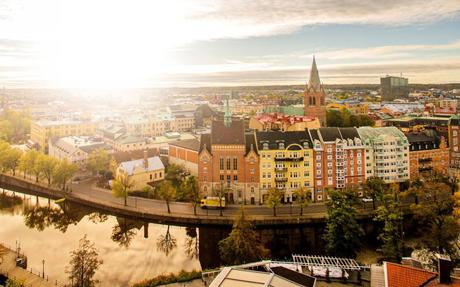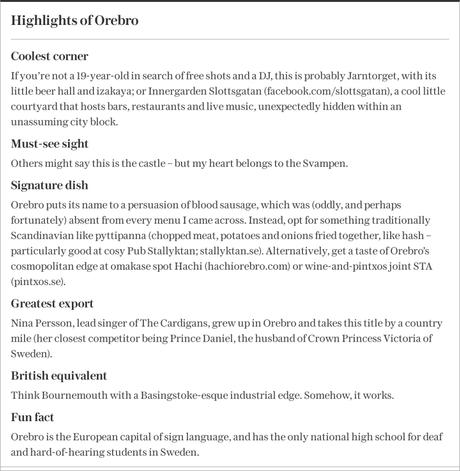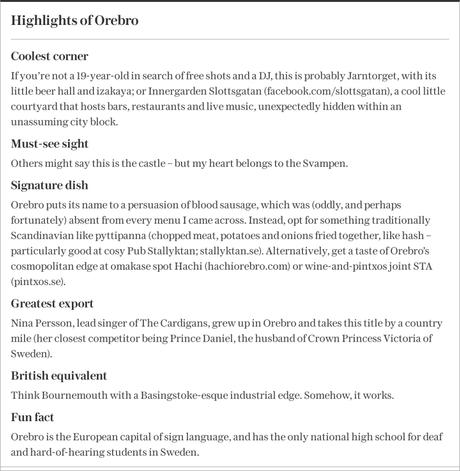
"Are you excited about the Svampen?" I asked eagerly, for the seventeenth time, as our plane taxied for take-off at Gatwick. My friend smiled faintly again. "Yes darling."
Before I was asked to visit the Swedish town of Orebro to assess its underrated reputation for a weekend getaway, I (like most British travellers, and I'd wager, quite a few Swedes) was unaware of its existence. of it. Full of enthusiasm, I quickly googled what Sweden's eighth largest metropolis has in store (untapped Scandi-cool! Fairytale castles! Scandinavian folklore!), and was rewarded with... the Svampen (literally The Mushroom), a big, but not -big-enough-to-be-really-exciting water tower. And apparently not much else. My heart sank.
But as our weekend of discovery approached, I gradually managed to drum up some excitement for the Svampen. The eighth largest cities can't all be showstoppers, and if this were Orebro's most beautiful attraction, to God we'd have some enthusiasm for it.
So we flew to Stockholm, where we took a break to meet Swedish friends for drinks, and asked if they had ever been to Orebro (pronounced "uhh-ruh-broo", they kindly explained, which was not how we were been). saying).
"Yes," was the answer, as they looked at us with politely concealed Swedish consternation. "It's a university town. We used to go there to get drunk," said a friend. "It's mainly students and elderly people, and not much in between," said another. "You tend to live there if you haven't left yet, or if you come back... at the end."
So student bars and pension complexes: a kind of Bournemouth without the seaside?
With some trepidation we left Stockholm and drove two hours west by train, finally pulling into Orebro central station around 9pm. It was very dark, but it had already been very dark several hours earlier, at four in the afternoon, when we landed in Stockholm. Not twilight, not a charming twilight, but a full, middle-of-the-night, all-pervading darkness, which felt extreme for this side of the Arctic Circle in early November.
The story continues
But it wasn't just dark: it was also raining, huge drops of extremely wet, icy rain. As we trudged through completely closed, completely sodden, completely silent streets - lined with cool Swedish chains (Ahlens department store, Bastard Burgers, Pressbyran supermarkets), run-down Thai massage parlors and sad modern apartment buildings - we began to doubt and wonder whether even a visit to the Svampen could save our minds.
Frankly, a brief look at the city's history puts its modern look somewhat into perspective. Located halfway between Stockholm and Gothenburg, and on a major river, Orebro has functioned as a commercial center since the 13th century. After a fire destroyed much of the center in 1854, it seems to have finally surrendered to its fate as a place for practical purposes, deciding not to worry too much about its aesthetics.
Reasonable. After all, a comparable approach has produced much less attractive cities than this one. Look at Milton Keynes.
Nevertheless, surrounded by icy fog and smooth concrete facades, it looked gloomy. And then we stumbled upon Jarntorget, one of the city's three main squares, and suddenly everywhere was ablaze with small, quaint pubs where plaid-shirted musicians strummed lively tunes on the double bass, and the kind of homely restaurants where the occasional Hamptons - chic hurricane lantern and quirky artwork complemented soft worn edges and hearty food. Everywhere, rosy-cheeked students and groups of lively retirees walked by without any friction.
Daring to hope this was the case everywhere, we walked the Svartan - the river that bisects the city - and found (mostly) more of the same, in addition to two antique shops and a shop selling handmade pipes, plus two karaoke bars. three small clubs guarded by neon-clad bouncers, and two sports bars. It was Friday evening and students are students after all.
At that point, Orebro started to make sense. Catering to two extremes at the same time - students who want to have fun with music and cheap beer and burgers, and retirees who want some of that too, but with a nice sophisticated edge and a decent wine list - it seems like a fantastic medium. And with a price tag to match: dinner for two, with drinks, cost us just £60 - quite a Scandi rarity.


The next day the fog gave way to a clear winter day with blue skies, and suddenly there was the city's spectacularly domed Swedish Renaissance castle, which had been hiding right next to our hotel in last night's fog.
We spent the day exploring and discovered that Orebro - with barely 150,000 inhabitants and a city center you can cross in less than 20 minutes on foot - is as compact as it is informal. By mid-afternoon we had visited the castle's neat little museum, the state apartments and an excellent photo exhibition on the upper floors (orebroslott.se/en); the Slottsparken, a beautiful park from the 1770s; two nondescript churches; a long, wide main street full of smart homeware stores and even more chains (a Specsavers here, a Burger King there); and Wadkoping, a charming open-air museum depicting the picturesque (pre-fire) Orebro of old.
By 2 p.m. we had largely completed the city, except for the Svampen. We walked a half hour north to what seemed like the outskirts of the city, past huge corporate warehouses, retirement apartments with striped awnings, and through a vast swamp that gave way to a lovely neighborhood of red and yellow houses with wraparound porches and gambrel roofs. .
Then there it was, sprouting from a grassy hill and stretching skyward in otherworldly mushroom glory. And at the top a small restaurant with a view over the city and a nature reserve to the east, as well as a bar, and a draft beer pump in the shape of - what else? - a Svampen.
Here, in beer-pouring miniature, the beauty of going beyond the usual city break fare was writ large - Orebro is (almost) everything that's beautiful about Stockholm, but on a smaller, friendlier, less cool scale. Where Stockholm begs for approval, Orebro is comfortable in its own skin: proudly average. It may not have the palaces or poise of some of its peers, but it takes itself less seriously altogether - and, honestly, what city wouldn't benefit from a dose of that?
Essentials
Ryanair (ryanair.com), Norwegian (norwegian.com), SAS (flysas.com) and British Airways (ba.com) all fly direct from London to Stockholm, with returns from £29. From there, take the Arlanda Express to the city (£31 return) and then the train onwards to Orebro, which takes just two hours and costs from £41 return (omio.com).
Gemma Knight was a guest at the Clarion Collection Hotel Borgen (00 46 1920 5000; Strawbeihotels.com), an impressive 19th-century building in the city center overlooking the Svartan River, which has double rooms from £86 per night , including breakfast, fika (coffee and cake) and dinner (excluding drinks).
See visitsweden.com or extra.orebro.se for more information
